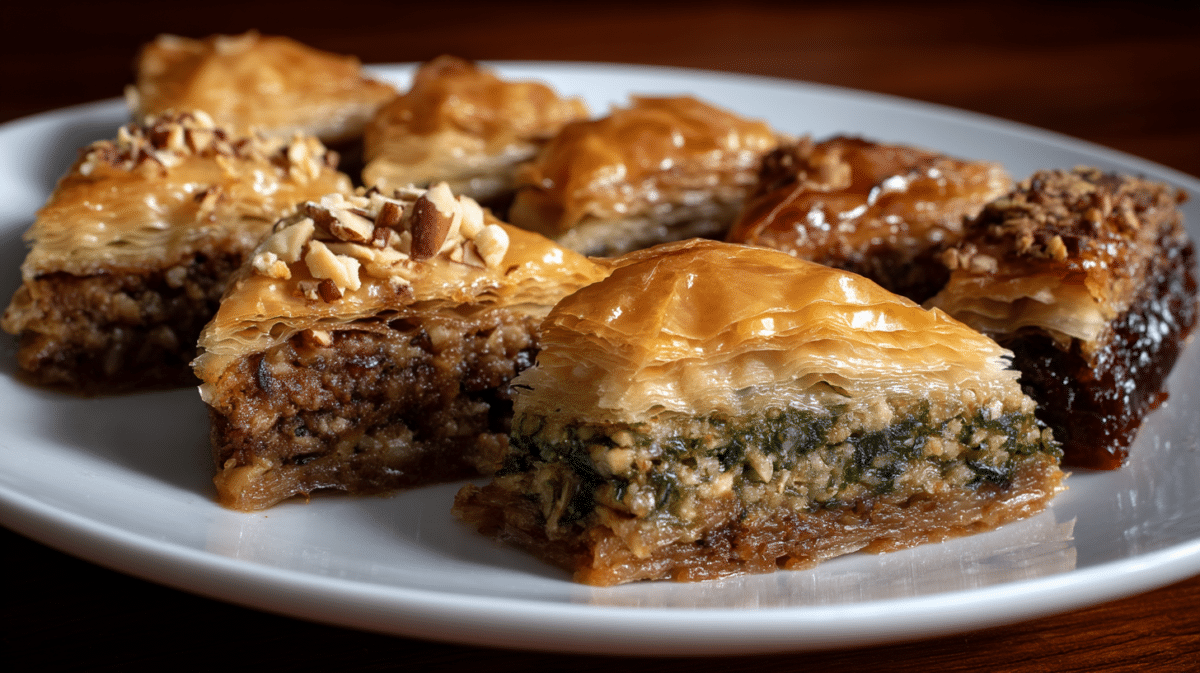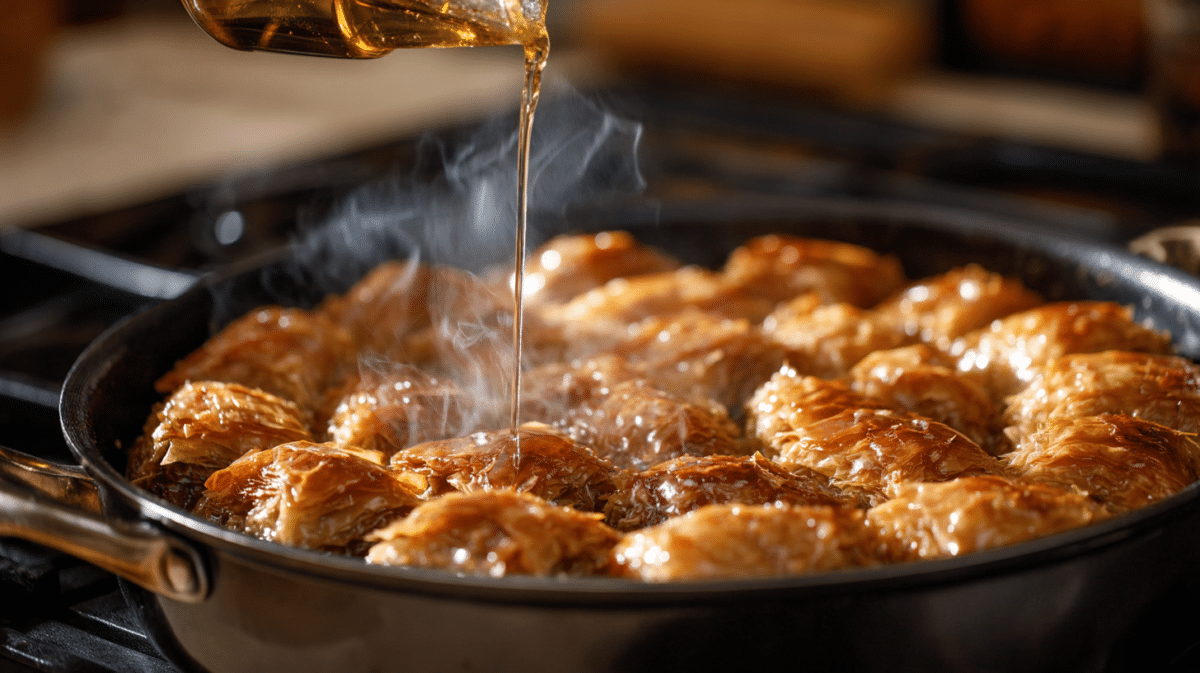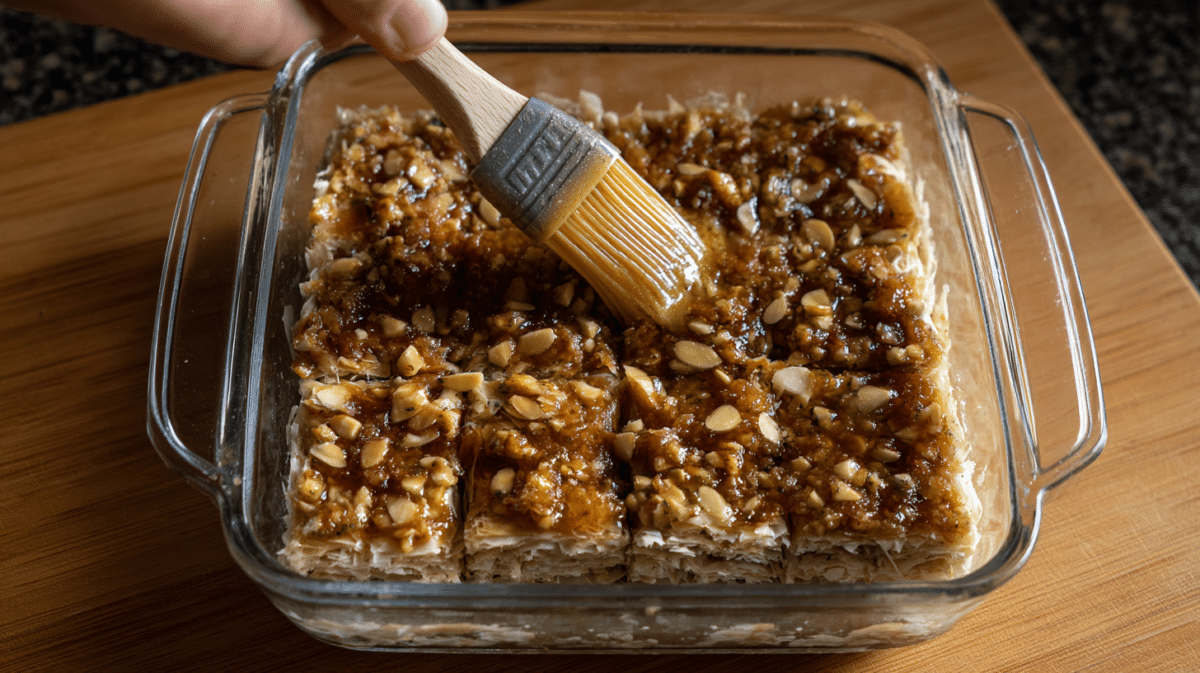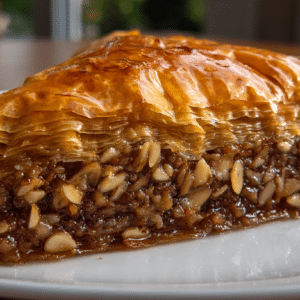Almond Baklava with Maple Syrup isn’t just a dessert—it’s an experience. This reinvented classic marries the deep, roasted flavor of almonds with the natural sweetness of maple syrup, offering a plant-based pastry that holds nothing back on crunch, flavor, or nostalgia. Traditionally dripping with honey and bursting with walnuts, baklava has seen many variations across borders and centuries. But this version? It’s a warm, flaky, and sweet phyllo dessert that’s both wholesome and indulgent.

Whether you’re looking to impress guests, surprise your family, or explore something new in your kitchen, this maple syrup-infused baklava hits all the right notes. Beyond taste, it’s a dairy-free dessert perfect for those seeking a vegan baklava or simply trying to cut back on refined sugars. Packed with almond crunch and layered in golden sheets of filo, it’s your go-to Mediterranean treat with a North American twist.
Don’t miss our frozen spin on this classic: Check out our Baklava Ice Cream recipe for another way to enjoy this iconic pastry.
Let’s dig into the origins of baklava—and how almond and maple became the new stars of this ancient pastry.
PrintAlmond Baklava with Maple Syrup – A Modern Twist on a Classic Dessert
- Prep Time: 10 minutes
- Cook Time: 45 minutes
- Total Time: 55 minutes
- Yield: 24 squares 1x
- Category: Dessert
- Cuisine: Mediterranean, Middle Eastern, Fusion
Ingredients
- 16 sheets of phyllo dough
- 1 cup chopped almonds
- 1 tsp cinnamon
- ½ cup vegan butter (melted)
- ¾ cup maple syrup
- ½ cup water
- 1 tsp vanilla extract
- Optional: ½ tsp rose water
Instructions
- Preheat oven to 350°F.
- Layer phyllo with brushed vegan butter.
- Add almond mix between layers.
- Bake 40–45 minutes until golden.
- Simmer syrup, then pour over cooled pastry.
- Rest for at least 4 hours before serving.
Notes
Store uncovered at room temperature for up to 5 days.
For a gluten-free version, use certified GF phyllo dough.
Freezes well for up to 3 months—thaw uncovered.
Nutrition
- Calories: 195
PART 1: The History and Evolution of Baklava
Origins of Baklava in Middle Eastern and Mediterranean Cultures
Baklava is one of those desserts whose origins are as layered as the pastry itself. Some trace its roots to the Assyrian Empire, where thin layers of dough were filled with chopped nuts and sweetened with honey. Others credit the Ottoman Empire for refining and popularizing baklava throughout what is now Turkey, Greece, Lebanon, and Armenia. Regardless of who did it first, baklava became a cherished dessert across Mediterranean and Middle Eastern tables—served during celebrations, holidays, and high feasts.
The traditional version uses walnuts or pistachios, but almonds began appearing in regions like North Africa and Spain due to local agriculture. This adaptation evolved naturally, bringing a nutty, subtly sweet profile that balances beautifully against buttery pastry layers.
Don’t miss our deep dive into Turkish paste candy and its cultural recipes, another rich regional dessert worth exploring.
How Almond Baklava Differs from Traditional Variants
So, what makes almond baklava stand apart from its walnut or pistachio cousins? It starts with texture and ends with taste. Almonds bring a cleaner, slightly milder crunch compared to the earthy depth of walnuts or the rich, buttery bite of pistachios. When paired with maple syrup, which carries warm, caramel-like notes, almond baklava transforms into a refined yet approachable dessert.
Almond-based baklava is also lighter in color, and its crisp finish pairs wonderfully with maple’s smooth sweetness. This version skips processed sugar and instead celebrates maple syrup—a natural sweetener rich in antioxidants and a favorite in plant-based baking. It’s especially popular among those searching for healthy baklava or vegan dessert alternatives.
Next, we’ll explore why maple syrup isn’t just a sweetener in this dish—it’s the hero.
PART 2: Why Use Maple Syrup in Almond Baklava
Maple Syrup vs. Honey or Sugar – Health and Flavor Benefits

Let’s be honest—almond baklava with maple syrup doesn’t just sound gourmet, it is gourmet. But there’s more to this choice than flair. Traditionally, baklava relies on honey or refined sugar syrups. While both add sweetness, they can overpower delicate flavors and spike your blood sugar in the process.
Maple syrup, on the other hand, is a natural sweetener with a more complex taste. It brings hints of vanilla, toffee, and spice—making it ideal for almond-forward desserts. It’s also lower on the glycemic index than refined white sugar, and unlike honey, it’s 100% plant-based, aligning perfectly with vegan baklava goals.
And don’t underestimate the flavor upgrade. Maple syrup highlights the roasted notes of almonds without masking them. The result is a phyllo pastry that’s nutty, buttery, and beautifully caramelized with a subtle smoky edge.
Check out our healthy twist on syrup-based pastries in the lazy cake recipe – no bake dessert, which also skips refined sugars for smarter alternatives.
Does Maple Syrup Make Baklava Vegan-Friendly?
Absolutely—and it’s one of the biggest reasons maple syrup is a rising star in modern baklava recipes. Traditional baklava often uses honey, which disqualifies it from being truly vegan. By replacing honey with pure maple syrup, baklava becomes fully plant-based while maintaining that sticky-sweet finish everyone loves.
But it goes beyond just sweetness. Maple syrup binds the layers and nuts just like honey does—but it spreads more evenly, resulting in consistent moistness throughout the dessert. Plus, it’s a cleaner ingredient, making it attractive for people with dietary sensitivities or those avoiding processed foods.
For another wholesome swap, don’t miss our vegan moussaka with lentils and cashew béchamel—a dish that’s just as indulgent but 100% dairy-free.
PART 3: Key Ingredients in Almond Maple Syrup Baklava
Choosing the Right Almonds and Other Nut Options
When crafting a perfect almond baklava with maple syrup, starting with the right almonds makes all the difference. Raw, unsalted almonds are best—they roast beautifully in the oven and release a naturally sweet, nutty aroma that complements the rich syrup. Avoid pre-roasted or salted almonds, which can distort the balance of flavors in this delicate phyllo dessert.
Texture is also key. Chop the almonds coarsely for a satisfying crunch. If you’re feeling adventurous, mix in pistachios or pecans for layered flavor. However, almonds should remain the star—giving your baklava a lighter, more refined bite.
If you’re experimenting with nut-based sweets, you might enjoy our cheeseburger crescent ring for a savory pastry twist with equally thoughtful texture.
Maple Syrup Grades and Their Impact on Taste
Not all maple syrup is created equal. When baking plant-based desserts like almond baklava, Grade A Dark Amber is your best choice. It offers a robust, molasses-like flavor that deepens during baking, creating that iconic glossy syrup layer.
Grade A Golden or Medium Amber can be used if you prefer a milder flavor. However, keep in mind that lighter syrups may get lost against the richness of the nuts and phyllo dough.
And remember: always opt for 100% pure maple syrup—not pancake syrup or blended products with additives. Real maple enhances the natural qualities of this dairy-free baklava and keeps it refined sugar-free.
Looking for a smart guide to global ingredients? Explore our fine bulgur wheat guide to learn more about pantry staples used in Mediterranean baking.
PART 4: Step-by-Step Guide to Making Almond Baklava with Maple Syrup
Preparing the Nut Mixture and Phyllo Layers

Ready to roll? To create a flaky, golden almond baklava with maple syrup, start with thawed phyllo dough. Keep the sheets covered with a damp cloth while working—they dry quickly. You’ll need around 16–20 sheets for proper layering.
Step-by-step layering process:
- Butter a 9×13” baking dish with melted plant-based butter or neutral oil.
- Place two sheets of phyllo dough, brush with butter, and repeat until 8 layers are built.
- Spread a generous handful of almond-cinnamon mixture across the layer.
- Add two more sheets of phyllo, brush with butter, and repeat the nut layering.
- Finish with 6–8 final sheets of phyllo, brushing each with butter.
Use a sharp knife to slice the unbaked baklava into diamonds or squares before baking. This ensures the syrup will seep evenly later.
Baking Tips to Achieve Perfect Crispiness
Bake your almond baklava at 350°F (180°C) for 40–45 minutes or until the top turns a rich golden brown. You’ll know it’s ready when the corners start to lift and the center layers crackle slightly.
Tips for crisp perfection:
- Don’t underbake—it results in a chewy center.
- Don’t over-butter—it can lead to sogginess.
- Let the baklava cool before pouring syrup, or you risk steaming the layers.
This section gives you the techniques to achieve crispy baklava without deep frying or additives. For more cooking tips rooted in tradition, visit our guide on grilled pita benefits and recipes.
PART 5: Secrets to Perfect Syrup Absorption and Texture
How to Make Maple Syrup Infusion That Soaks Just Right
The soul of any almond baklava with maple syrup is in the syrup itself. A thin, glossy, aromatic glaze that trickles into every layer, infusing the nuts and dough with sweetness. But for it to do its job, timing and technique matter.
Start by combining pure maple syrup, water, and a pinch of sea salt. Simmer on low heat until slightly reduced—don’t let it thicken too much, or it won’t soak properly. For added depth, a splash of vanilla extract or a few drops of rose water can elevate the aroma and give a subtle floral finish—common in Mediterranean-style pastries.
Unlike honey, which hardens as it cools, maple syrup stays smooth and distributes more evenly across the layers, making it the perfect sweetener for plant-based pastries like vegan baklava.
Timing the Syrup Pour – Before or After Baking?
This question separates baklava lovers from baklava masters. Always pour the syrup after baking, but make sure either the baklava is hot and the syrup is cool, or the reverse. This temperature contrast helps the syrup absorb rather than pool on the surface.
For almond baklava with maple syrup, it’s best to let the pastry rest for 5–10 minutes after baking before slowly pouring room-temperature maple syrup over it. The syrup will gently seep into the cuts you made earlier, moistening every layer without making it soggy.
Let it rest uncovered at room temperature for a few hours or overnight before serving. This ensures your phyllo dessert is crispy on top and sticky-sweet inside—just the way it should be.
Don’t miss our orphan pick: Sweet on Fall: 6 Autumn Desserts, which offers more seasonal inspiration for warm, spiced treats like this one.
PART 6: Serving and Storing Almond Baklava with Maple Syrup
Creative Ways to Present This Modern Dessert
Serving almond baklava with maple syrup is an art form. The visual appeal of golden phyllo, glistening syrup, and toasted almond garnish makes it the ideal dessert for celebrations, holidays, or even brunch tables.
Here are some creative ways to plate it:
- Top with finely chopped pistachios for color contrast.
- Add orange zest for a citrusy twist.
- Serve with coconut cream or a dairy-free vanilla gelato for an indulgent pairing.
Whether you cut it into traditional diamonds or neat squares, presentation adds the final wow factor. Don’t forget to add a small drizzle of warm maple syrup just before serving for extra shine.
Looking for seasonal plating ideas? Discover our orphan link: It’s High Time for Pie Time, packed with presentation tips and fall dessert pairings.
How to Store for Maximum Freshness and Crunch
Baklava is all about the crisp. But storing it the wrong way can turn your masterpiece soggy. Here’s how to keep your vegan baklava fresh:
DO:
- Store at room temperature, uncovered, in a dry place.
- Use a parchment-lined container or a cooling rack with a loose cover.
DON’T:
- Don’t refrigerate it—it traps moisture.
- Don’t seal it in airtight plastic—it will lose its crispiness.
If you’re making it ahead of time, baklava can last up to a week this way. And yes, it freezes well! Just wrap it tightly and thaw uncovered at room temperature for a crunchy, ready-to-serve treat.
Next up, we’ll explore how almond baklava with maple syrup fits into a health-conscious lifestyle and how you can make it even lighter.
PART 7: Nutritional Insights and Healthier Tweaks
Comparing Calories: Maple Syrup vs. Traditional Sugar
One of the perks of using maple syrup in almond baklava is the nutritional edge it offers over refined sugar or honey. While both are sweeteners, pure maple syrup contains small amounts of minerals like zinc, calcium, and manganese. It’s also lower on the glycemic index than table sugar, meaning it won’t spike blood sugar quite as fast—something health-conscious dessert lovers appreciate.
When comparing traditional baklava made with sugar-heavy syrup to this plant-based pastry, you’re looking at fewer additives and a more natural sweetening process. Almonds bring heart-healthy fats and a boost of protein, while phyllo dough—especially when brushed lightly with vegan butter or olive oil—keeps the fat content in check.
For those managing calories or sugar intake, small tweaks can go a long way. Try using a thinner layer of syrup, or reducing the number of phyllo layers while keeping the almond ratio high for a more nutrient-dense version of this maple syrup dessert.
Craving other smart swaps? Don’t miss our article on Greek yogurt pumpkin bread for another balance of indulgence and wellness.
Making Gluten-Free or Vegan Almond Baklava
This vegan baklava is naturally dairy-free, but with a couple of smart changes, it can be gluten-free too. Simply swap standard phyllo dough for a certified gluten-free version. While gluten-free phyllo can be trickier to handle, keeping the sheets moist with a damp cloth and working quickly will help prevent tearing.
Other tips for full plant-based alignment:
- Use vegan butter or coconut oil for brushing the layers.
- Stick to 100% maple syrup—no blends or artificial syrups.
- Add flax or chia seeds for an extra fiber boost in the nut mix.
When done right, this dessert becomes a beautiful example of a dairy-free, gluten-free, plant-based treat that doesn’t sacrifice texture or taste.
PART 8: Common Mistakes and Expert Tips for Success
Why Your Baklava Might Get Soggy or Too Dry
Making almond baklava with maple syrup might look simple, but small missteps can compromise texture or flavor. Here are the most common mistakes to avoid—and how to fix them:
1. Over-buttering the layers:
Too much fat between sheets can cause them to steam rather than bake crisp. Brush lightly and evenly.
2. Underbaking the center:
This can result in soggy layers. Make sure your oven is properly preheated, and bake until uniformly golden brown—check the center with a knife tip.
3. Pouring hot syrup on hot baklava:
It might seem efficient, but it leads to mushy layers. Stick with the classic rule: hot meets cool. Either syrup or baklava must be cooled before combining.
4. Covering during storage:
This traps moisture and ruins the crisp texture. Always store your phyllo dessert uncovered at room temp.
Looking for savory versions of layered delights? Check out our feature on stuffed zucchini boats with herbed quinoa, a healthy, baked dish that uses similar layering principles.
Tools and Techniques Used by Pastry Chefs
Pastry chefs often rely on a few secrets to perfect baklava texture and uniformity. If you want your maple syrup pastry to look and taste professional, try these tools:
- Pastry brush: Essential for even butter application.
- Ultra-sharp knife: Ensures clean, pre-bake cuts that let syrup seep in without crumbling.
- Nonstick metal baking pan: Promotes even heat distribution.
- Cooling rack with paper lining: Keeps air flowing for crisp storage.
Mastering these small tricks ensures every batch of your vegan almond baklava is bakery-level good.
Next, we’ll wrap up with Part 9: a look at global twists and creative flavor infusions that make almond baklava even more exciting.
PART 9: Variations and Global Twists on Almond Baklava
Turkish, Greek, and Lebanese Style Compared
What makes almond baklava with maple syrup uniquely North American is the choice of sweetener. But in the broader world of baklava, ingredients and techniques vary widely.
- Turkish baklava is typically made with pistachios and often uses clarified butter (ghee). The syrup is lighter, made with lemon juice and sugar, and poured cold over hot pastry. It’s known for its finely ground nuts and tight, precise layering.
- Greek baklava often leans into walnuts, sometimes spiced with cloves or nutmeg. It uses a honey-based syrup, and layers are thicker, producing a more rustic texture.
- Lebanese baklava is often flavored with rose or orange blossom water and may include semolina in the nut mix. It tends to be drier and less sticky but more fragrant.
What makes maple syrup baklava stand out is its smooth, caramel-like sweetness and subtle smokiness—making it ideal for American and Canadian palates seeking a modern take on this ancient dessert.
Looking to explore more authentic Mediterranean flavors? Check out our post on Tunisian couscous with lamb, a beautifully layered savory dish with historical roots.
Infusing New Flavors: Cardamom, Rose Water, and Orange Blossom
If you’re ready to elevate your plant-based pastry, try infusing it with fascinating aromatics. Just a dash of cardamom in the almond mix or a teaspoon of rose water in the maple syrup can completely change the flavor profile.
Here are a few flavor variations to experiment with:
- Rosewater & Almond: For a Middle Eastern flair, add 1 tsp rosewater to your syrup.
- Orange Blossom & Pistachio: Sub out half the almonds for pistachios and add a few drops of orange blossom extract.
- Spiced Maple: Simmer the maple syrup with a cinnamon stick and 2 crushed cardamom pods for a warm winter twist.
These additions not only boost flavor—they also enhance the cultural richness of this globally inspired maple syrup dessert.
FAQ SECTION
Turkish baklava is lighter, made mostly with pistachios, and uses clarified butter and a lemon-sugar syrup. Almond baklava with maple syrup, on the other hand, features a deeper nut flavor and richer sweetness thanks to roasted almonds and pure maple syrup. It’s more aligned with plant-based and Western dessert preferences.
Absolutely. Maple syrup is a fantastic substitute for sugar in baking, offering a more complex flavor and fewer processed ingredients. In baklava, it blends beautifully with almonds and adds a rich finish without the heaviness of traditional syrup.
Yes—but moderation is key. Too much syrup can make the layers soggy. For almond baklava with maple syrup, a light to medium pour after baking ensures optimal absorption and maintains that crispy top. Always let the syrup soak in slowly and avoid reheating.
Crispy baklava comes down to three things: proper layering, balanced buttering, and post-bake syrup timing. Make sure to bake long enough for golden edges and let your maple syrup pastry cool slightly before adding syrup to lock in the crunch.
Conclusion
Almond Baklava with Maple Syrup is the perfect fusion of tradition and modern taste. With every bite, you get the delicate crunch of golden phyllo, the nutty richness of toasted almonds, and the warm sweetness of pure maple syrup. Whether you’re hosting a dinner party, prepping a holiday spread, or just exploring plant-based dessert ideas, this recipe delivers both wow-factor and simplicity.
By skipping the processed sugar and opting for natural ingredients, this vegan baklava variation proves that you can honor the past while baking for the future.
Love baklava? Want more plant-based dessert ideas like this?
Follow us on Pinterest for weekly recipe inspiration:
👉 Visit our Pinterest page and save this Almond Baklava with Maple Syrup to your favorite board!

